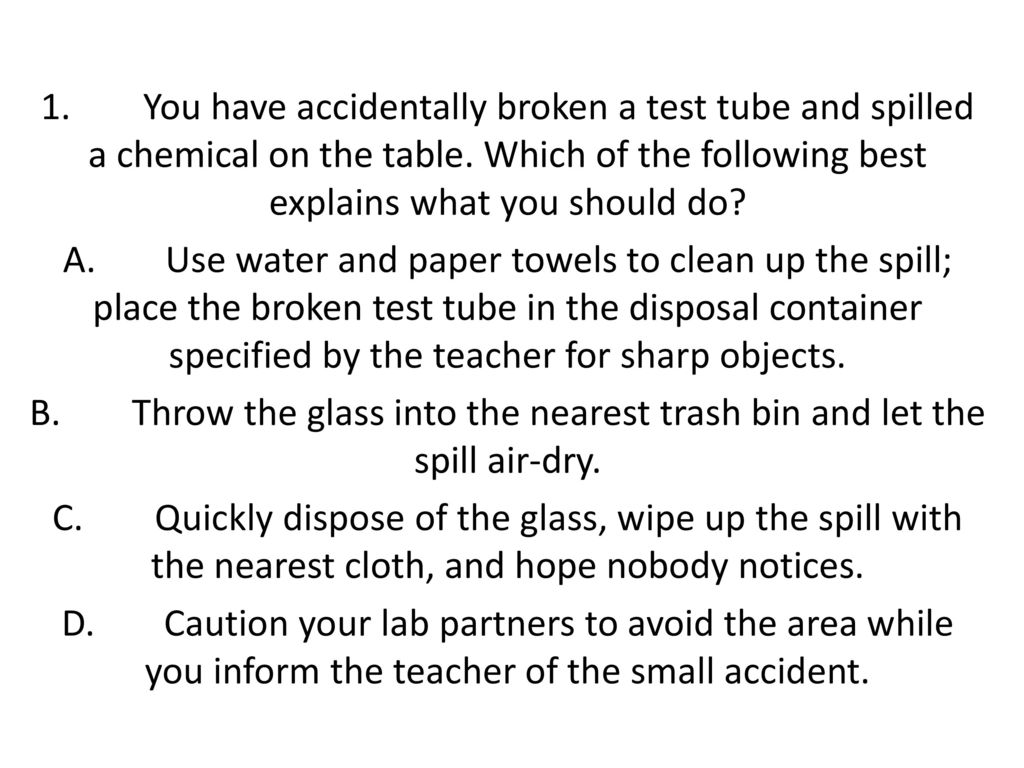What is the first thing you should do if there is ever a spill or accident in the laboratory?

When working in a laboratory setting, spills and accidents can happen unexpectedly. It is crucial to know how to handle these situations promptly and safely to minimize any potential risks or damages. In this article, we will explore the importance of taking immediate action, the common types of laboratory spills and accidents, a step-by-step guide to handling them, as well as prevention and safety measures.
Understanding the Importance of Prompt Action
Time is of the essence when it comes to laboratory spills and accidents. Taking immediate action can help prevent the situation from escalating and causing further harm. It is essential to act swiftly to protect yourself, others, and the environment. Delaying the response can put everyone at risk and may lead to severe consequences.
Common Types of Laboratory Spills and Accidents
Laboratory spills and accidents can vary in nature and severity. Some common types include chemical spills, biological spills, fires, breakages, and personal injuries. Each type requires a different approach and should be handled accordingly.
Step-by-Step Guide to Handling Laboratory Spills and Accidents
1. Assess the situation: Evaluate the type and extent of the spill or accident. Determine if it requires immediate attention or if it can be managed safely by yourself.
2. Ensure personal safety: Put on the appropriate personal protective equipment (PPE) before approaching the spill or accident site. This may include gloves, goggles, lab coat, or a respirator, depending on the situation.
3. Contain the spill: If it is safe to do so, try to contain the spill by using absorbent materials, barriers, or safety cones. This will help prevent the spread of hazardous substances and reduce the risk of further contamination or accidents.
4. Notify others: Inform your supervisor, colleagues, or any individuals nearby about the spill or accident. This will ensure that everyone is aware of the situation and can take necessary precautions.
5. Clean up the spill: Follow the appropriate procedures for cleaning up the spill based on the type of substance involved. Use the recommended cleaning agents and equipment to minimize the risks of exposure or environmental damage.
6. Dispose of waste properly: Dispose of any contaminated materials or waste following the laboratory's guidelines and regulations. Use designated waste containers and labels to ensure proper disposal.
7. Report and document: Report the spill or accident to the appropriate authorities or personnel within the laboratory. Document the incident, including the date, time, individuals involved, and actions taken. This information can be valuable for future reference or analysis.
Prevention and Safety Measures
Preventing spills and accidents in the laboratory is crucial for maintaining a safe working environment. Here are some essential prevention and safety measures:
- Proper training: Ensure that all laboratory personnel receive comprehensive training on handling hazardous substances, emergency procedures, and the proper use of equipment.
- Regular inspections: Conduct routine inspections of the laboratory to identify any potential hazards or maintenance issues that could lead to accidents.
- Safe storage: Store chemicals and other hazardous substances in designated areas with appropriate labeling and containment measures.
- Clear pathways: Keep walkways and work areas clear of clutter to minimize the risk of tripping and falling.
- Emergency preparedness: Have a well-defined emergency response plan in place, including evacuation procedures, emergency contacts, and the location of safety equipment.
Conclusion
Handling laboratory spills and accidents requires immediate action and proper knowledge. By following the step-by-step guide and implementing prevention and safety measures, you can effectively manage such incidents and ensure the well-being of everyone in the laboratory. Remember, safety should always be the top priority in any laboratory setting.
Frequently Asked Questions
1. What should be the first thing you do if there is a spill or accident in the laboratory?
If there is a spill or accident in the laboratory, the first thing you should do is assess the situation and ensure your personal safety by putting on the appropriate personal protective equipment (PPE).
2. How should you handle chemical spills?
When handling chemical spills, it is essential to contain the spill, notify others, and clean up the spill following the recommended procedures for that particular chemical. Always refer to the safety data sheet (SDS) for specific instructions.
3. What precautions should be taken when dealing with biological spills?
When dealing with biological spills, it is crucial to wear gloves, lab coat, and eye protection. Use appropriate disinfectants and follow the laboratory's protocols for containment, decontamination, and disposal of biological materials.
4. What personal protective equipment (PPE) should be worn when cleaning up a spill?
The personal protective equipment (PPE) worn when cleaning up a spill may vary depending on the nature of the spill. Generally, it includes gloves, goggles, lab coat, and closed-toe shoes. In some cases, a respirator or additional protective gear may be necessary.

Leave a Reply